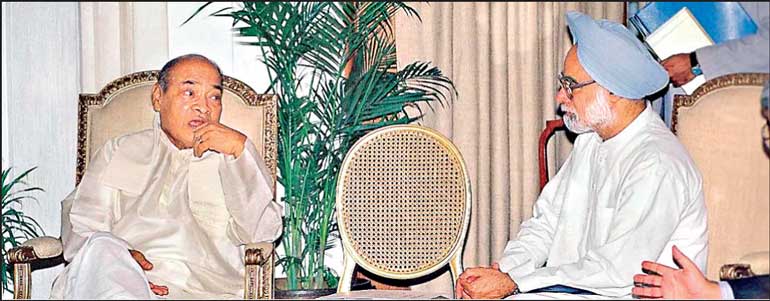Saturday Dec 06, 2025
Saturday Dec 06, 2025
Friday, 8 April 2022 00:00 - - {{hitsCtrl.values.hits}}

Prime Minister P.V.N. Rao (left) with his handpicked Finance Minister Dr. Manmohan Singh in 1991
 Dr Bhabani Sonowal
Dr Bhabani Sonowal
It was a time when India was struggling to recuperate from one of the darkest periods in its economy; the unemployment rate was on the rise, prices of essentials were skyrocketing, and depression among the public widened. Consequently, people had been left with no option but to take their desperations to the streets and express their emotions against the ruling administration. Unprecedented challenges were looming. But, on the other side, serious likeminded intelligent minds had already started working around the clock to find solutions to mitigate the impact of national calamity. Their profound commitments and dedications structurally transformed India.
It was the height of the Gulf War and the collapse of the USSR, India’s top diplomatic collaborator which enabled bilateral trade in local currency. On the other hand, the power of Prime Minister P.V. Narasimha Rao, the successor of Rajiv Gandhi, was challenged by political instability. But, Rao, despite all hurdles, seized the opportunity and deployed correct and unspoiled economic enablers in place by giving them the freedom to think and demonstrate their duties. He was honest about the subject he did not know so much but his political wisdom enlightened him to choose the right person at the right moment. “I don’t understand economics… Pranab and you have to explain,” he once told Jairam Ramesh and Pranab Mukherjee during the peak of the economic crisis.
Today, Sri Lanka is passing through a difficult time due to the severe economic crisis, manifested through chronological events starting since independence but more recently the 2019 Easter blasts, unwise tax reduction, and COVID-19 pandemic have multiplied the crisis. A series of events contributed to the depletion of the foreign exchange beyond recovery due to which imports of essentials were restricted tremendously resulting in the worst economic crisis in the island nation.
However, Sri Lanka is not the first of its kind to go through such an economic crisis nor will it be the last one, the only way out is through a proper strategy and genuine expert involvement. If we look back in history there are innumerable instances of economic crises in many parts of the world. So it is time for Sri Lanka to revisit the strategies applied by those countries to overcome the current situation, a way out. As mentioned earlier, the best example would be the economic crisis in India in 1991, which bought a major economic reform in the country.
India being the immediate neighbouring country has always extended a helping hand to Sri Lanka, and in this current situation also it is not indifferent. If Sri Lanka could seek help from India in any situation, why not follow the strategies India followed to overcome the 1991 economic crisis. Though India was always proud of maintaining its economy since its independence in 1991, India was on the brink of default.
As per the Economic Survey (1991-92), “by June 1991, the balance of payments crisis had become overwhelmingly a crisis of confidence – of confidence in the government’s ability to manage the balance of payments…A default on payments, for the first time in our history, had become a serious possibility in June 1991.”
As one of analysts recited, “that the 1991 crisis had manifold roots central among which is the growing recourse to various forms of external borrowing to finance a series of large trade and current account deficits in the latter half of the eighties. The foreign exchange reserves were also run down to finance the unsustainable external deficit and in mid-1991 foreign exchange reserves were barely sufficient to meet two weeks’ import bills.”
According to the New Economic Policy of India, the balance of payments was due to more expenditure by the government whereas the income generated was less. In addition, there were huge disparities between income and expenditure. The amount of foreign debt that the government was unable to repay was increasing exponentially. The foreign exchange reserves, which were maintained to import petroleum and other essentials dropped to levels that were not sufficient to last even a fortnight. The crisis was further compounded by rising prices of essential goods in the local market.
Thus, reducing the fiscal deficit became of the utmost essential for India in 1991 to face the crisis. In an immediate response to the crisis, “The Government of India secured an emergency loan of $ 2.2 billion from the International Monetary Fund by pledging 67 tons of India’s gold reserves as collateral. It is reported that the Reserve Bank of India had to airlift 47 tons of gold to the Bank of England and 20 tons of gold to the Union Bank of Switzerland to raise $ 600 million.” Though, later on, the immediate move of the Government had to face criticism but it helped the country to tide over the balance of payment crisis for the time being and paved the way for the economic reform process in India.
Apart from all other factors the political instability and uncertainty also triggered the delay of the balance of payment. During the period from 1989 to May 1991, there were three coalition governments and three Prime Ministers in India due to which there was a delay in the balance of payment and led to a loss of the confidence of the investors. So a stable and efficient government was the call of the time to take a corrective move, thus P.V. Narasimha Rao was appointed as the Prime Minister of India and in aiming toward corrective policy measures Dr. Manmohan Singh an economist, who had been a technocrat in the government of India and was well-regarded in global policy circles was appointed, as his finance minister.
Dr. Manmohan Singh with an aim of reintegrating India into the world economy and liberalising the market for economic growth, proposed a new economic reform in India. In his budget speech before proposing the reforms Dr. Manmohan Singh has reiterated, “There is no time to lose. Neither the Government nor the economy can live beyond its means year after year. The room for manoeuvre, to live on borrowed money or time, does not exist anymore… We need to expand the scope and the area for the operation of market forces.”
Unlike many other leaders who initiated drastic economic reforms in various countries, Rao was not so lucky. His path was not on the rosy road, and he struggled to prevent India from bankruptcy. Just as he did not have the political power enjoyed by leaders such as Reagan, Thatcher and Nehru, so did parliament or even his own party. Rarely has a week passed without him being challenged by dissidents in Congress. But, Rao’s government was the first minority government to complete its constitutional tenure in Indian history by surviving multiple parliamentary troubles. It was able to change the fate of the Indians forever. It is no less a miracle.
As the saying goes, extraordinary times require extraordinary measures; thus, keeping in line with the preconditions of bailout from IMF, the economic restructuring was meticulously planned out and proposed by the veteran economist Dr. Manmohan Singh. The economic reform proposed by Dr. Singh includes both long-term structural measures and short-term stabilisation measures. The long-term measures are aimed at improving the efficiency of the economy and increasing its international competitiveness by removing the rigidities in various segments of the Indian economy and liberalising the Indian economy by making avenues for foreign direct investments. The short-term measures were proposed to address the immediate way out of the 1991 economic crisis which included correcting the weakness which resulted in the balance of payments crisis and steps to bring the inflation and crisis under control. Other proposed reforms were tax reforms, foreign exchange reforms, and trade and investment policy reforms.
In this context, it is worth mentioning that the current situation in Sri Lanka is no less than 1991 India, so an immediate way out from the crisis is desired for the interest of the society and to restore normalcy. In other words, it is not a hyperbole to presume that this beautiful ideal nation with warm smiling people and exceptional hospitality are facing the 1991 India’s moment. As a welfare state, it is the duty and responsibility of all the individuals and leaders for collective and constructive decision-making, leaving aside all the political motives and propagandas.
(The writer earned her PhD from the Indian Institute of Technology in Kharagpur, India in Criminal Law and worked as an Assistant Professor (Senior Grade) at the School of Law, Vellore Institute Technology. Her areas of interest are Criminal Law, Constitutional Law, Reparation and Institutional Reforms. The views expressed in this article are writer’s own.)